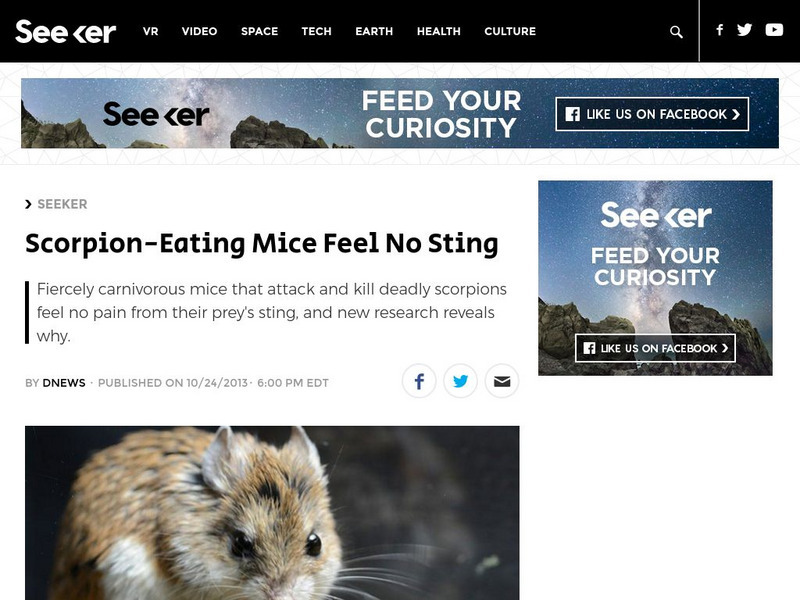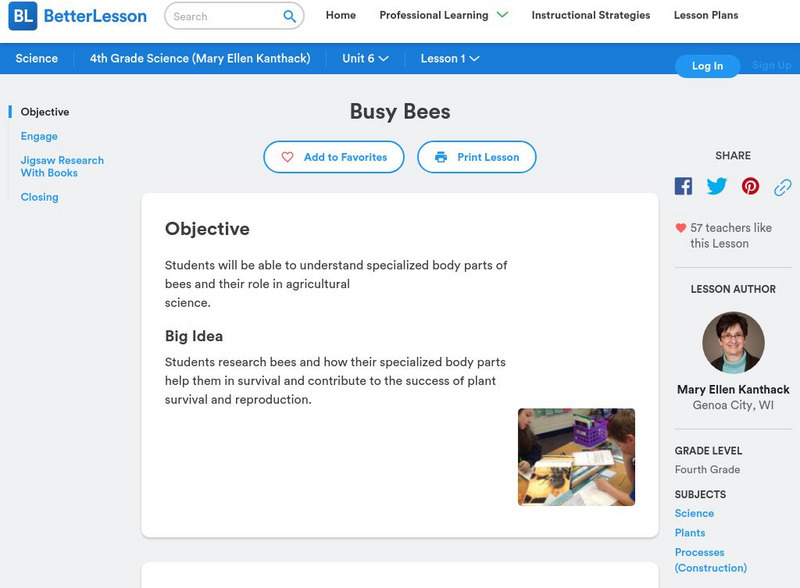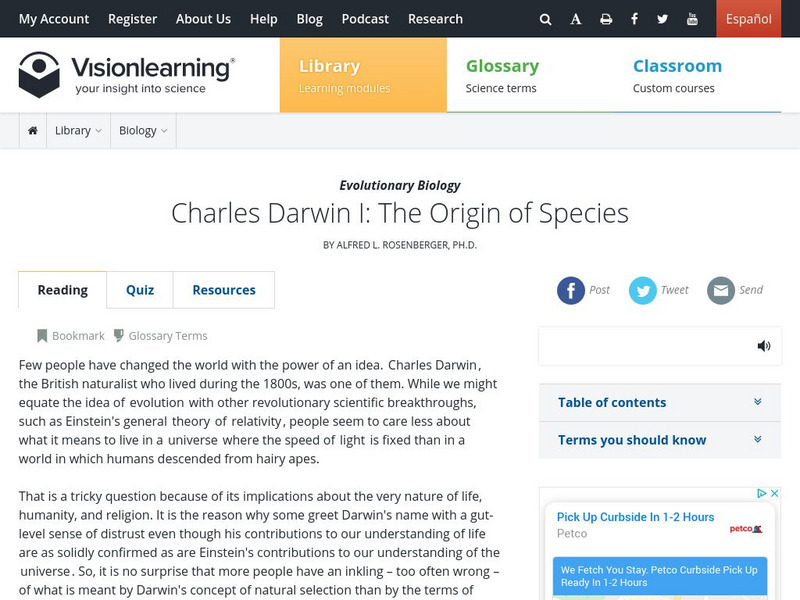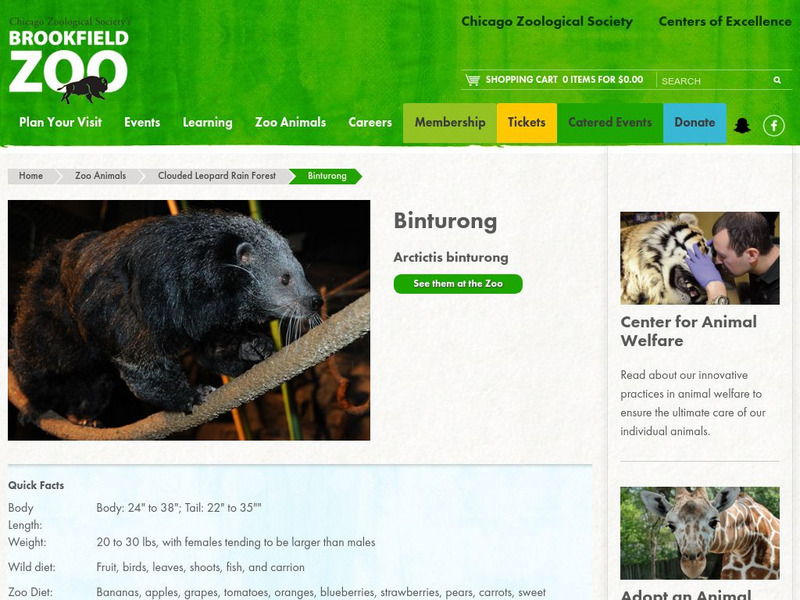Better Lesson
Better Lesson: Would Your Animal Survive Here? Day 1
Determine whether an animal can survive in a different environment than its own based on its inherited traits.
Alabama Learning Exchange
Alex: Now You See Me, Now You Don't!
An animal's physical characteristics, such as its body color, may give it a better chance of survival. For example, the body colors of many animals blend with their background. In this investigation, students will see that body color may...
Alabama Learning Exchange
Alex: Animal Environment and Adaptation
In this lesson, students will enjoy different activities focusing on how animals adapt to their environments. They will begin by researching two animals, their environment, and the ways the animals adapt to this environment. In small...
Alabama Learning Exchange
Alex: Animal Adaptations
Students use technology tools to research and produce a multimedia product on animals and their habitats. This a collaborative project involving the library media specialist, classroom teacher, and special education teacher.
Other
Arizona Sonora Desert Museum: Animal Fact Sheet: Bobcat
This fact sheet on the bobcat provides details on physical characteristics, adaptations, range, habitat, conservation, diet, and other interesting facts. Click the link to hear how a bobcat sounds.
Science Struck
Science Struck: Grassland Biome: Animals and Plants
Describes the characteristics, biodiversity, and the adaptations of the plants and animals of temperate and tropical grasslands.
PBS
Pbs Learning Media: Arctic Ice Extent, 1999 2016
Scientists study sea ice extent closely because it influences global climate. Follow the decline in Arctic sea ice in this animation adapted from NASA showing the yearly maximum and minimum sea ice extents from 1999 to 2016. Resources...
Alabama Learning Exchange
Alex: Creature Comforts
What do living things need to survive? In this unit, students explore different habitats and the adaptations made by living things to survive. Students will create a website matching an animal's adaptations to its environment. Then, they...
Seeker
Seeker: Week of 10 28 13: Scorpion Eating Mice Feel No Sting
Article reports on the scientific discovery that the venom of a scorpion has an unusual reaction in grasshopper mice, actually blocking the mouse from feeling pain instead of inducing it.
PBS
Pbs Learning Media: Ingredients for Life: Water
This video segment adapted from NOVA goes on a whimsical journey in search of life forms thriving in extreme conditions on Earth and in outer space. Animations show ice on Jupiter's moon, Europa, and signs that water once existed on...
NC State University
Nc State University: General Entomology, Elements of Behavior
Behavior is what animals do. It can be defined more precisely as an internally directed system of adaptive activities that facilitate survival and reproduction. Ethology is the scientific study of animal behavior -- particularly when...
Better Lesson
Better Lesson: Busy Bees
Fourth graders research bees and how their specialized body parts help them in survival and contribute to the success of plant survival and reproduction.
Vision Learning
Visionlearning: Biology: Charles Darwin I: The Origin of Species
Instructional module focusing on the early work of Charles Darwin. Discusses Darwin's key role in supporting and describing the theory of evolution as driven by natural selection. Site also includes an interactive practice quiz and links...
Chicago Zoological Society
Chicago Zoological Society: Zoo Explorer: Binturong
Learn all about the binturong by browsing this reference from the Brookfield Zoo. In addition to quick facts and a photo, this animal guide provides information on the appearance, habitat, and eating habits of this well adapted animal.
Smithsonian Institution
National Museum of Natural History: Hall of Mammals: Leopard Seal
Brief overview of the leopard seal and an accompanying photo demonstrate the physical adaptations that allow this animal to eat meat.
Smithsonian Institution
National Museum of Natural History: Hall of Mammals: Scimitar Horned Oryx
Brief overview of the Scimitar-horned oryx and accompanying photos demonstrate the physical adaptations that allow this animal to survive the desert heat.
Smithsonian Institution
National Museum of Natural History: Hall of Mammals: Canadian Lynx
A brief overview of the Canadian lynx and accompanying photos demonstrate the physical adaptations that allow this animal survive in its habitat.
Other popular searches
- Ocean Animal Adaptations
- Fantasy Animal Adaptations
- Plant and Animal Adaptations
- Animal Adaptations Behaviors
- Animal Adaptations +Wetlands
- Animal Adaptations Wetlands
- Animal Adaptations Eating
- Desert Animal Adaptations
- Animal Adaptations to Cold
- Animal Adaptations and Math
- Oceanic Animal Adaptations
- Animal Adaptations Oceans








